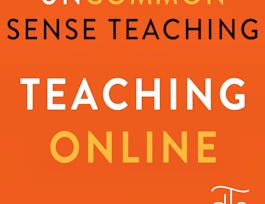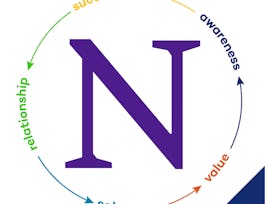In Part 2 of Uncommon Sense Teaching: Building Community and Habits of Learning, you will explore the following areas more deeply—helping you to connect with the latest insights into research and have fun while you are doing it!


Uncommon Sense Teaching: Part 2, Building Community and Habits of Learning
This course is part of Uncommon Sense Teaching Specialization
Taught in English
Some content may not be translated



Instructors: Dr. Terrence Sejnowski
Top Instructor
5,565 already enrolled
Included with 
Course
(106 reviews)
Recommended experience
Skills you'll gain
Details to know

Add to your LinkedIn profile
8 quizzes
Course
(106 reviews)
Recommended experience
See how employees at top companies are mastering in-demand skills

Build your subject-matter expertise
- Learn new concepts from industry experts
- Gain a foundational understanding of a subject or tool
- Develop job-relevant skills with hands-on projects
- Earn a shareable career certificate


Earn a career certificate
Add this credential to your LinkedIn profile, resume, or CV
Share it on social media and in your performance review

There are 4 modules in this course
This week’s materials cover motivation, stress, and character change—vitally important topics for us as teachers. We’ll learn about the importance of surprise in learning—part of what can make good teaching both surprising and rewarding! We’ll also discover why we like to say that “Curiosity is Queen” —and why being taken by surprise can be a very good thing when it comes to learning. We’ll also learn about the “Drama King"—that is, the amygdala—which can underpin some of our subconscious biases. And we’ll begin setting the stage to understand why cramming is so effective. At least, for short periods of time! Neuroscience is uncovering new insights about motivation. This brings us to a seemingly different area—unreachable, unteachable students who can tell you exactly what you want to hear, without any internal motivation for change no matter what you may do to try to motivate them. Perhaps surprisingly—bullying isn’t just a problem for students—it can actually be a problem amongst teachers themselves, with some of the best teachers bearing the brunt of the bullying behavior. But guess what—sometimes our best approach to help students sail successfully through stressful situations in life is to simply do what we teachers are born to do—teach with passion and with heart. All this, and more, in this week’s videos!
What's included
9 videos4 readings2 quizzes1 discussion prompt
This week, we’ll learn how the brain decides whether to make some mental or physical task conscious or nonconscious—it all depends on how often we do it! We’ll also be sneaking in through both the front and back doors of the brain’s different learning systems. Of course, both declarative and procedural ways of learning can have advantages and drawbacks. But as we’ll see, having information deposited in procedural sets of links can be like having a nicely wrapped package of movements or thoughts that a student's working memory can automatically grab onto, instead of having to think through each tiny movement or thought individually. This can not only speed students’ learning—it can even make classroom management easier. Using the magic of the procedural system, your classroom can run like a well-oiled machine, seemingly without you doing anything!
What's included
9 videos2 readings2 quizzes1 plugin
This week is full of surprises as we dig deeper into the advantages and disadvantages of faster and slower types of learning. Who knew that those who struggle with their learning—our hikers—can actually be more accurate with what they learn? For them, it can be easier to flexibly accept and change their minds when the data shows they are wrong. On the other hand, our race cars, who can learn faster and remember better, can also find it difficult to accept when they’re wrong. And all this relates in a very deep way, as you’ll see, with our ability to think critically. Join us as we explore all these ideas, and more, in this week’s videos! (And don’t forget, there’s plenty of optional extra info in the readings!)
What's included
9 videos2 readings2 quizzes
Syndromes such as dyslexia or attention deficit disorder can sometimes exert subtle effects that can make learning more difficult even though no diagnosis has been made. Other times, as with famed director Steven Spielberg and his dyslexia, a student's learning challenges can simply escape detection altogether. For teachers of these students, the best approach is to nurture these students’ ways of learning, rather than forcing them to learn like the majority of other students. Surprisingly often, this involves teaching more toward the procedural system for some students, and more toward the declarative system for others. All of this means that careful planning of your lessons is in order. What do we mean by careful planning? That's the subject of our final videos--we'll give you a template and insights to help guide your activities and allow you to soar in your teaching!
What's included
7 videos3 readings2 quizzes1 peer review
Instructors

Offered by
Recommended if you're interested in Education

Deep Teaching Solutions

Coursera Project Network

Yale University

Northwestern University
Why people choose Coursera for their career




Learner reviews
Showing 3 of 106
106 reviews
- 5 stars
90.56%
- 4 stars
9.43%
- 3 stars
0%
- 2 stars
0%
- 1 star
0%

Open new doors with Coursera Plus
Unlimited access to 7,000+ world-class courses, hands-on projects, and job-ready certificate programs - all included in your subscription
Advance your career with an online degree
Earn a degree from world-class universities - 100% online
Join over 3,400 global companies that choose Coursera for Business
Upskill your employees to excel in the digital economy
Frequently asked questions
Access to lectures and assignments depends on your type of enrollment. If you take a course in audit mode, you will be able to see most course materials for free. To access graded assignments and to earn a Certificate, you will need to purchase the Certificate experience, during or after your audit. If you don't see the audit option:
The course may not offer an audit option. You can try a Free Trial instead, or apply for Financial Aid.
The course may offer 'Full Course, No Certificate' instead. This option lets you see all course materials, submit required assessments, and get a final grade. This also means that you will not be able to purchase a Certificate experience.
When you enroll in the course, you get access to all of the courses in the Specialization, and you earn a certificate when you complete the work. Your electronic Certificate will be added to your Accomplishments page - from there, you can print your Certificate or add it to your LinkedIn profile. If you only want to read and view the course content, you can audit the course for free.
If you subscribed, you get a 7-day free trial during which you can cancel at no penalty. After that, we don’t give refunds, but you can cancel your subscription at any time. See our full refund policy.

